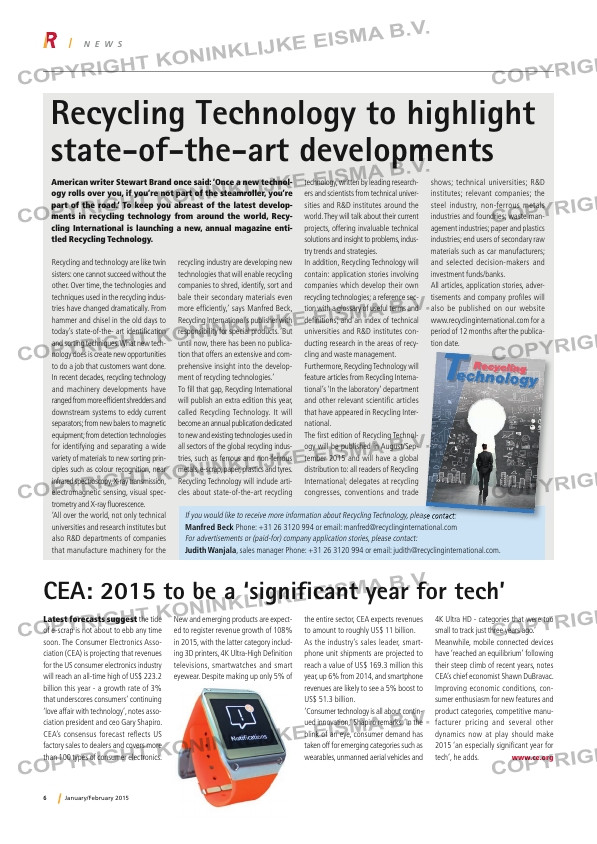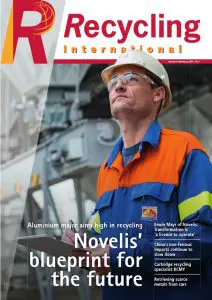Page 6 from: January / February 2015

6 January/February 2015
N E W S
Recycling and technology are like twin
sisters: one cannot succeed without the
other. Over time, the technologies and
techniques used in the recycling indus-
tries have changed dramatically. From
hammer and chisel in the old days to
today’s state-of-the- art identifi cation
and sorting techniques. What new tech-
nology does is create new opportunities
to do a job that customers want done.
In recent decades, recycling technology
and machinery developments have
ranged from more effi cient shredders and
downstream systems to eddy current
separators; from new balers to magnetic
equipment; from detection technologies
for identifying and separating a wide
variety of materials to new sorting prin-
ciples such as colour recognition, near
infrared spectroscopy, X-ray transmission,
electromagnetic sensing, visual spec-
trometry and X-ray fl uorescence.
‘All over the world, not only technical
universities and research institutes but
also R&D departments of companies
that manufacture machinery for the
recycling industry are developing new
technologies that will enable recycling
companies to shred, identify, sort and
bale their secondary materials even
more effi ciently,’ says Manfred Beck,
Recycling International’s publisher with
responsibility for special products. ‘But
until now, there has been no publica-
tion that offers an extensive and com-
prehensive insight into the develop-
ment of recycling technologies.’
To fi ll that gap, Recycling International
will publish an extra edition this year,
called Recycling Technology. It will
become an annual publication dedicated
to new and existing technologies used in
all sectors of the global recycling indus-
tries, such as ferrous and non-ferrous
metals, e-scrap, paper, plastics and tyres.
Recycling Technology will include arti-
cles about state-of-the-art recycling
technology, written by leading research-
ers and scientists from technical univer-
sities and R&D institutes around the
world. They will talk about their current
projects, offering invaluable technical
solutions and insight to problems, indus-
try trends and strategies.
In addition, Recycling Technology will
contain: application stories involving
companies which develop their own
recycling technologies; a reference sec-
tion with a glossary of useful terms and
defi nitions; and an index of technical
universities and R&D institutes con-
ducting research in the areas of recy-
cling and waste management.
Furthermore, Recycling Technology will
feature articles from Recycling Interna-
tional’s ‘In the laboratory’ department
and other relevant scientifi c articles
that have appeared in Recycling Inter-
national.
The fi rst edition of Recycling Technol-
ogy will be published in August/Sep-
tember 2015 and will have a global
distribution to: all readers of Recycling
International; delegates at recycling
congresses, conventions and trade
shows; technical universities; R&D
institutes; relevant companies; the
steel industry, non-ferrous metals
industries and foundries; waste man-
agement industries; paper and plastics
industries; end users of secondary raw
materials such as car manufacturers;
and selected decision-makers and
investment funds/banks.
All articles, application stories, adver-
tisements and company profi les will
also be published on our website
www.recyclinginternational.com for a
period of 12 months after the publica-
tion date.
Recycling Technology to highlight
state-of-the-art developments
American writer Stewart Brand once said: ‘Once a new technol-
ogy rolls over you, if you’re not part of the steamroller, you’re
part of the road.’ To keep you abreast of the latest develop-
ments in recycling technology from around the world, Recy-
cling International is launching a new, annual magazine enti-
tled Recycling Technology.
If you would like to receive more information about Recycling Technology, please contact:
Manfred Beck Phone: +31 26 3120 994 or email: [email protected]
For advertisements or (paid-for) company application stories, please contact:
Judith Wanjala, sales manager Phone: +31 26 3120 994 or email: [email protected].
Latest forecasts suggest the tide
of e-scrap is not about to ebb any time
soon. The Consumer Electronics Asso-
ciation (CEA) is projecting that revenues
for the US consumer electronics industry
will reach an all-time high of US$ 223.2
billion this year – a growth rate of 3%
that underscores consumers’ continuing
‘love affair with technology’, notes asso-
ciation president and ceo Gary Shapiro.
CEA’s consensus forecast refl ects US
factory sales to dealers and covers more
than 100 types of consumer electronics.
New and emerging products are expect-
ed to register revenue growth of 108%
in 2015, with the latter category includ-
ing 3D printers, 4K Ultra-High Defi nition
televisions, smartwatches and smart
eyewear. Despite making up only 5% of
the entire sector, CEA expects revenues
to amount to roughly US$ 11 billion.
As the industry’s sales leader, smart-
phone unit shipments are projected to
reach a value of US$ 169.3 million this
year, up 6% from 2014, and smartphone
revenues are likely to see a 5% boost to
US$ 51.3 billion.
‘Consumer technology is all about contin-
ued innovation,’ Shapiro remarks. ‘In the
blink of an eye, consumer demand has
taken off for emerging categories such as
wearables, unmanned aerial vehicles and
4K Ultra HD – categories that were too
small to track just three years ago.’
Meanwhile, mobile connected devices
have ‘reached an equilibrium’ following
their steep climb of recent years, notes
CEA’s chief economist Shawn DuBravac.
Improving economic conditions, con-
sumer enthusiasm for new features and
product categories, competitive manu-
facturer pricing and several other
dynamics now at play should make
2015 ‘an especially signifi cant year for
tech’, he adds. www.ce.org
CEA: 2015 to be a ‘significant year for tech’
RI1_NEWS.indd 6 22-01-15 12:24



